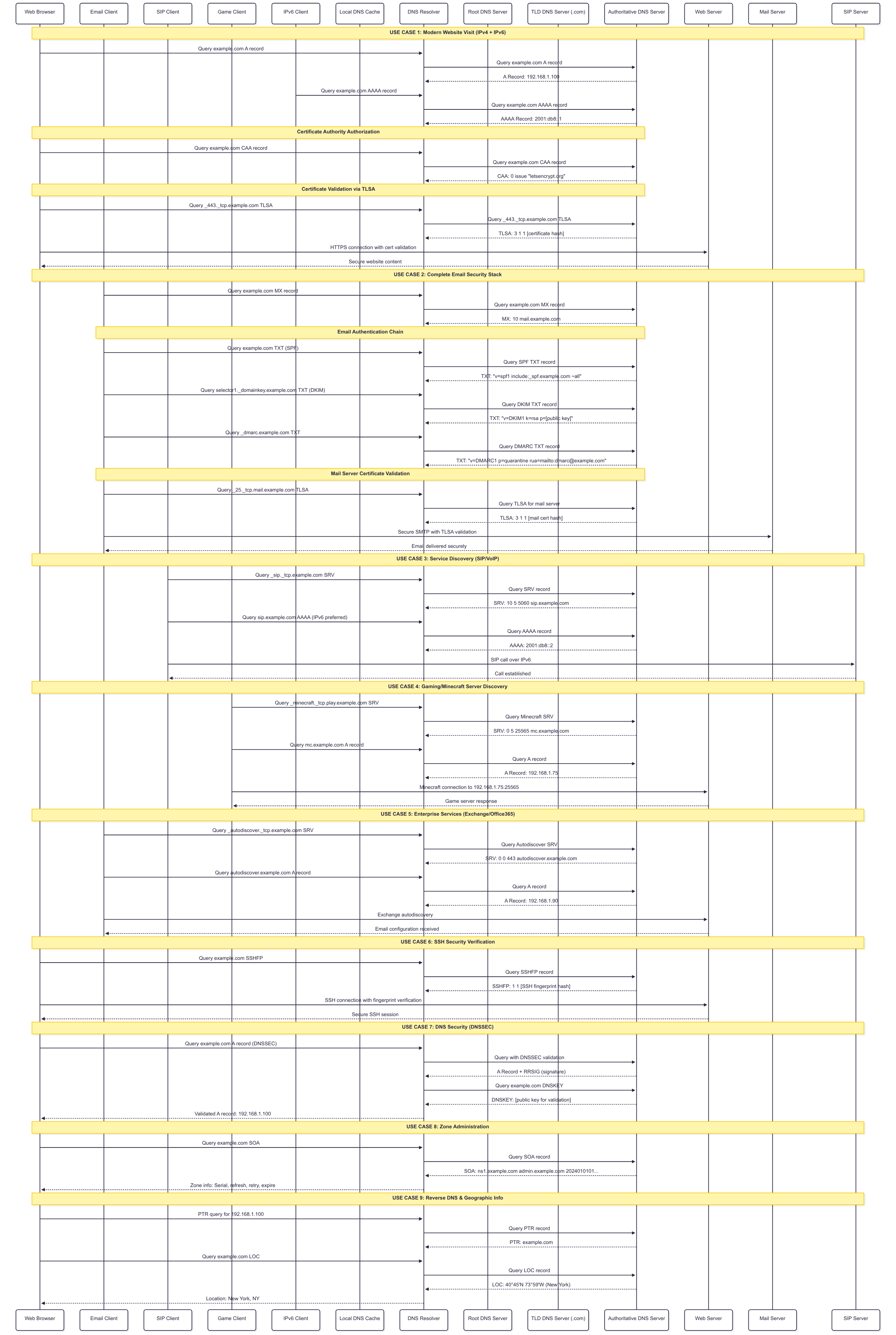DNS Resolution Flow

Have you ever wondered what happens before a request reaches a server? This post attempts to describe some of these processes and practical use cases linked to them.

USE CASE 1: Modern Website Visit (IPv4 + IPv6)
Real Example: You're browsing to netflix.com
- What happens: Your browser tries both IPv4 (A) and IPv6 (AAAA) records simultaneously
- IPv6 preference: If you have IPv6 connectivity, modern browsers prefer IPv6 for better performance
- CAA check: Your browser (or certificate authority) verifies that only authorized CAs (like DigiCert) can issue certificates for Netflix
- TLSA validation: Advanced security setups verify the actual certificate matches the cryptographic hash stored in DNS
Who does this: Every internet user, automatically, billions of times per day
USE CASE 2: Complete Email Security Stack
Real Example: Your company acmecorp.com is setting up professional email
- What the admin does:
- Sets up MX records pointing to
mail.acmecorp.com - Configures SPF to specify which servers can send email for the domain
- Sets up DKIM with a private key on the mail server and public key in DNS
- Configures DMARC policy (reject, quarantine, or monitor suspicious emails)
- Adds TLSA records for the mail server's SSL certificate
- Sets up MX records pointing to
Who does this: IT administrators, email service providers (like Google Workspace, Microsoft 365)
USE CASE 3: Service Discovery (SIP/VoIP)
Real Example: Your company uses a VoIP phone system
- What happens: When someone calls
john@acmecorp.com, the phone system:- Looks up
_sip._tcp.acmecorp.comSRV record - Finds the SIP server at
voip.acmecorp.com:5060 - Establishes the call connection
- Looks up
Who does this: VoIP administrators, telecommunications companies, unified communications platforms
USE CASE 4: Gaming/Minecraft Server Discovery
Real Example: A Minecraft server owner wants a clean domain
- What they do: Instead of telling players to connect to
mc.example.com:25565, they set up:- SRV record:
_minecraft._tcp.play.example.com→mc.example.com:25565 - Now players can just connect to
play.example.comand Minecraft automatically finds the right server and port
- SRV record:
Who does this: Game server administrators, gaming communities, hosting providers
USE CASE 5: Enterprise Services (Exchange/Office365)
Real Example: Setting up Outlook email clients in a company
- What happens: When you enter your email in Outlook, it:
- Queries
_autodiscover._tcp.yourcompany.comSRV record - Finds the autodiscover server (like
autodiscover.outlook.com) - Automatically configures server settings, ports, encryption
- User doesn't have to manually enter server details
- Queries
Who does this: IT departments, Microsoft Exchange administrators, Office365 migrations
USE CASE 6: SSH Security Verification
Real Example: A security-conscious sysadmin connecting to servers
- What they do:
- Set up SSHFP records with SSH key fingerprints in DNS
- When connecting via SSH, the client can verify the server's identity against DNS
- Prevents man-in-the-middle attacks even on first connection
- Command:
ssh -o VerifyHostKeyDNS=yes user@server.com
Who does this: Security engineers, DevOps teams, high-security environments
USE CASE 7: DNS Security (DNSSEC)
Real Example: A bank wants to prevent DNS hijacking of their website
- What they do:
- Sign all their DNS records with cryptographic signatures (RRSIG)
- Publish public keys (DNSKEY) in DNS
- When users visit the bank's site, DNSSEC-aware resolvers verify the signatures
- If someone tries to hijack the DNS, the signature verification fails
Who does this: Financial institutions, government agencies, security-critical organizations
USE CASE 8: Zone Administration
Real Example: A DNS administrator managing company.com
- What they actually do:
- Check SOA serial number: See if DNS changes have propagated (
dig company.com SOA) - Monitor refresh intervals: Ensure secondary DNS servers are syncing properly
- Track zone transfers: Know when the last zone update occurred
- Troubleshoot replication: When DNS changes aren't appearing on all servers
- Check SOA serial number: See if DNS changes have propagated (
Daily tasks:
- "Why isn't the new A record showing up on our backup DNS server?"
- "When did we last update the DNS zone?"
- "Are our secondary DNS servers getting updates?"
Who does this: DNS administrators, hosting providers, domain registrars, enterprise IT teams
USE CASE 9: Reverse DNS & Geographic Info
Real Example: Email server administration and network troubleshooting
- Reverse DNS (PTR):
- Email admin sets PTR record so
192.168.1.100resolves tomail.company.com - Prevents emails from being marked as spam
- Network admin uses
nslookup 192.168.1.100to identify mystery servers in logs
- Email admin sets PTR record so
- Geographic Info (LOC) - Rarely used, but when it is:
- University network admin documents server locations for inventory
- ISP marks network infrastructure locations for planning
- Research networks studying internet topology
Who does this: Email administrators, network engineers, security analysts, ISP technicians
Each of these represents real work that thousands of people do every day to keep the internet running smoothly!



